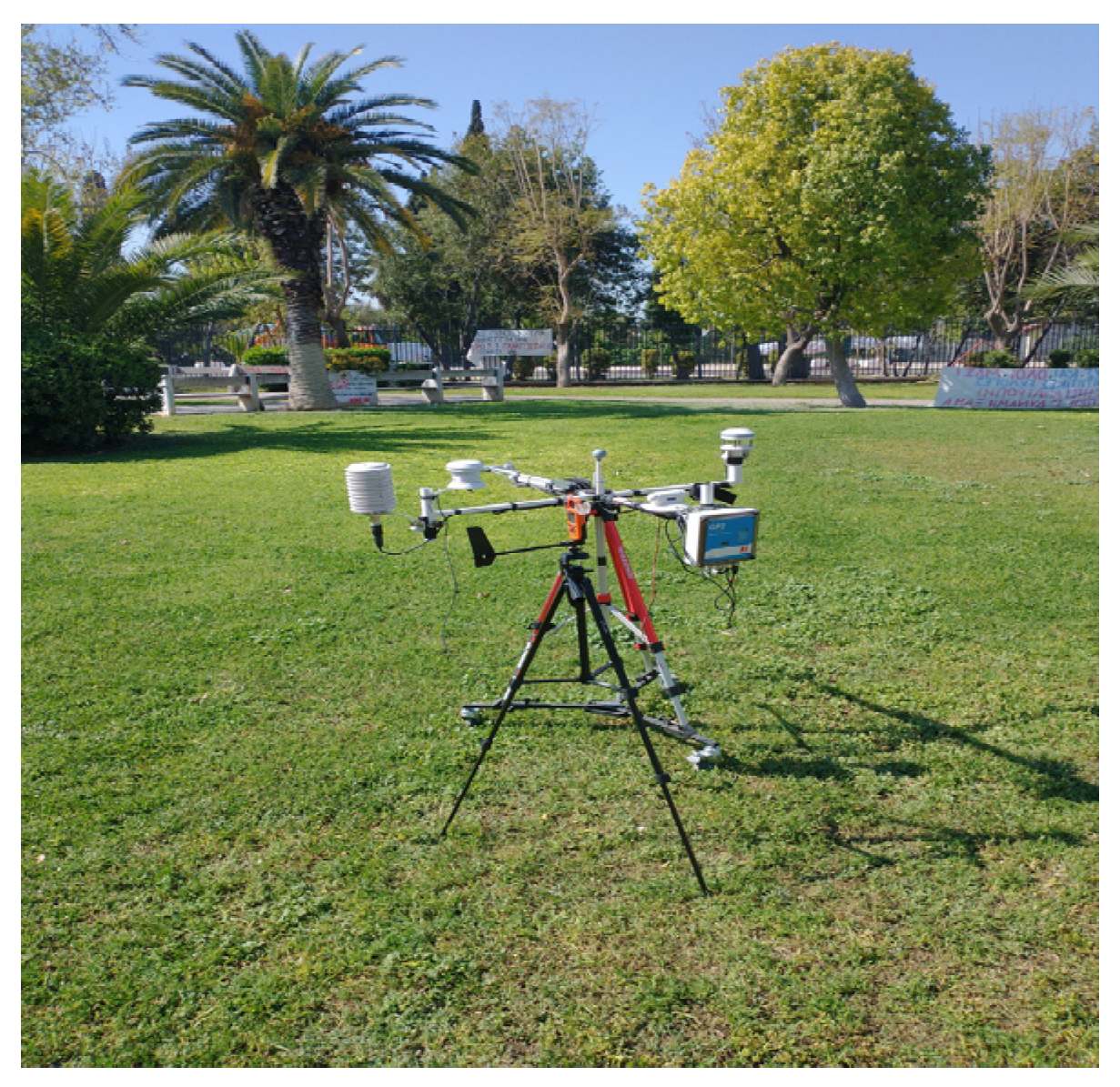Evaluation of Urban Bioclimatic Measurements towards an Easier and more Affordable Method of Instrumental Monitoring †
Abstract
:1. Introduction
2. Methodology
3. Results
4. Conclusions
Author Contributions
Funding
Institutional Review Board Statement
Informed Consent Statement
Data Availability Statement
Acknowledgments
Conflicts of Interest
References
- Tseliou, A.; Tsiros, I.X.; Nikolopoulou, M.; Papadopoulos, G. Outdoor thermal sensation in a Mediterranean climate (Athens): The effect of selected microclimatic parameters. Arch. Sci. Rev. 2015, 59, 190–202. [Google Scholar] [CrossRef]
- Matzarakis, A.; Nastos, P. Heat Waves in Athens. In Proceedings of the 8th Conference on Meteorology-Climatology-Atmospheric Physics, Athens, Greece, 25–29 September 2023; pp. 153–160. [Google Scholar]
- Tapias, E.; Matzarakis, A.; Schmitt, G. First results of the data acquisition and analysis of microclimate conditions in Barranquilla, Colombia. In Proceedings of the ICUC9—9th International Conference on Urban Climate. NOMTM6: Urban Climate Measurement Networks, Toulouse, France, 20–24 July 2015. [Google Scholar] [CrossRef]
- Wang, R.; Zhao, J.; Meitner, M.J.; Hu, Y.; Xu, X. Characteristics of urban green spaces in relation to aesthetic preference and stress recovery. Urban For. Urban Green. 2019, 41, 6–13. [Google Scholar] [CrossRef]
- Kalogeropoulos, G.; Dimoudi, A.; Toumboulidis, P.; Zoras, S. Urban Heat Island and Thermal Comfort Assessment in a Medium-Sized Mediterranean City. Atmosphere 2022, 13, 1102. [Google Scholar] [CrossRef]
- Jin, H.; Cui, P.; Wong, N.H.; Ignatius, M. Assessing the Effects of Urban Morphology Parameters on Microclimate in Singapore to Control the Urban Heat Island Effect. Sustainability 2018, 10, 206. [Google Scholar] [CrossRef]


| Kestrel 5400 | HOBO MX2302A | ADCON TR1 | Atmos 22 | PT100 | ||||||
|---|---|---|---|---|---|---|---|---|---|---|
| Ta | RH | Tg | WS | Ta | RH | Ta | RH | WS | Tg | |
| Range | −29 to 70 °C | 10 to 90% 25 °C noncondensing | −29.0 to 60.0 °C | 0.6 to 40 m/s | −40 to 70 °C | 0 to 100% | −40 to 60 °C | 0 to 100% | 0 to 30 m/s | −50 to 500 °C |
| Accuracy | 0.5 °C | 2% | 1.4 °C | Larger of 3% of measurement, least significant digit or 0.1 m/s | 0.2 °C from 0 to 70 °C | ±2.5% from 10% to 90% | <±0.1 °C @ 20 °C | ±1% from 0 to 90% | Larger of 0.3 m/s or 3% of measurement | ±0.3 °C at 0 °C |
| Resolution | 0.1 °C | 0.1% | 0.1 °C | 0.1 m/s | 0.02 °C | 0.01% | Logger dependent | Logger dependent | 0.01 m/s | Logger dependent |
| Descriptives (Ta/°C) | |||||
|---|---|---|---|---|---|
| TaS | TaK | TaH | ΔTaS-TaK | ΔTaS-TaH | |
| Mean | 24.12 | 25.05 | 25.05 | −0.92 | −0.92 |
| Median | 24.60 | 25.30 | 25.42 | −0.85 | −0.90 |
| Standard deviation | 1.41 | 1.64 | 1.57 | 0.76 | 0.26 |
| Range | 5.90 | 7.10 | 6.70 | 3.80 | 1.13 |
| Minimum | 20.15 | 21.30 | 20.70 | −3.35 | −1.61 |
| Maximum | 26.05 | 28.40 | 27.40 | 0.45 | −0.48 |
| Descriptives (RH/%) | |||||
|---|---|---|---|---|---|
| RHS | RHK | RHH | ΔRHS-RHK | ΔRHS-RHH | |
| Mean | 34.82 | 36.92 | 37.15 | −2.10 | −2.33 |
| Median | 34.70 | 37.00 | 36.96 | −2.15 | −2.25 |
| Standard deviation | 1.92 | 1.99 | 2.11 | 1.00 | 0.84 |
| Range | 8.85 | 8.40 | 10.12 | 4.80 | 4.94 |
| Minimum | 30.85 | 32.70 | 32.77 | −4.10 | −4.94 |
| Maximum | 39.70 | 41.10 | 42.89 | 0.70 | −0.00 |
| Descriptives (Tg/°C) | |||
|---|---|---|---|
| TgS | TgK | ΔTgS-TgK | |
| Mean | 30.02 | 34.50 | −4.48 |
| Median | 30.70 | 37.00 | −4.85 |
| Standard deviation | 3.88 | 6.39 | 3.14 |
| Range | 14.10 | 20.60 | 13.25 |
| Minimum | 21.55 | 21.50 | −10.65 |
| Maximum | 35.65 | 42.10 | 2.60 |
| Descriptives (WS/m/s) | |||
|---|---|---|---|
| WSS | WSK | ΔWSS-WSK | |
| Mean | 0.95 | 0.94 | 0.02 |
| Median | 0.94 | 0.90 | 0.06 |
| Standard deviation | 0.30 | 0.47 | 0.37 |
| Range | 1.58 | 2.00 | 1.66 |
| Minimum | 0.18 | 0.00 | −0.82 |
| Maximum | 1.76 | 2.00 | 0.84 |
Disclaimer/Publisher’s Note: The statements, opinions and data contained in all publications are solely those of the individual author(s) and contributor(s) and not of MDPI and/or the editor(s). MDPI and/or the editor(s) disclaim responsibility for any injury to people or property resulting from any ideas, methods, instructions or products referred to in the content. |
© 2023 by the authors. Licensee MDPI, Basel, Switzerland. This article is an open access article distributed under the terms and conditions of the Creative Commons Attribution (CC BY) license (https://creativecommons.org/licenses/by/4.0/).
Share and Cite
Melas, E.; Mela, A.; Tsiros, I.; Varelidis, G. Evaluation of Urban Bioclimatic Measurements towards an Easier and more Affordable Method of Instrumental Monitoring. Environ. Sci. Proc. 2023, 26, 142. https://doi.org/10.3390/environsciproc2023026142
Melas E, Mela A, Tsiros I, Varelidis G. Evaluation of Urban Bioclimatic Measurements towards an Easier and more Affordable Method of Instrumental Monitoring. Environmental Sciences Proceedings. 2023; 26(1):142. https://doi.org/10.3390/environsciproc2023026142
Chicago/Turabian StyleMelas, Emmanouil, Athina Mela, Ioannis Tsiros, and Georgios Varelidis. 2023. "Evaluation of Urban Bioclimatic Measurements towards an Easier and more Affordable Method of Instrumental Monitoring" Environmental Sciences Proceedings 26, no. 1: 142. https://doi.org/10.3390/environsciproc2023026142
APA StyleMelas, E., Mela, A., Tsiros, I., & Varelidis, G. (2023). Evaluation of Urban Bioclimatic Measurements towards an Easier and more Affordable Method of Instrumental Monitoring. Environmental Sciences Proceedings, 26(1), 142. https://doi.org/10.3390/environsciproc2023026142






